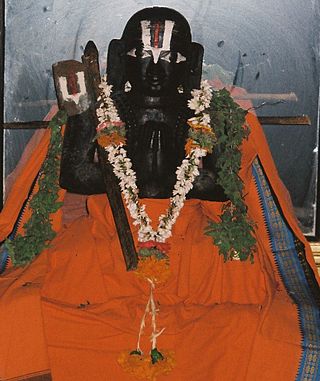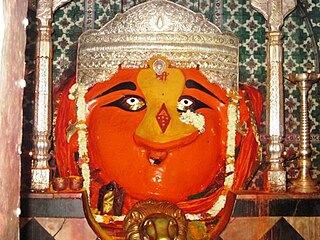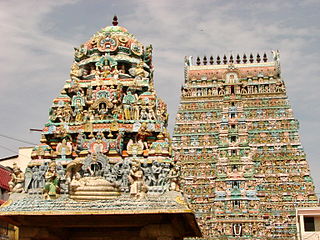
Vishvamitra is one of the most venerated rishis or sages of ancient India. Vishvamitra is one of the seven Brahmarshi. According to Hindu tradition, he is stated to have written most of the Mandala 3 of the Rigveda, including the Gayatri Mantra (3.62.10). The Puranas mention that only 24 rishis since antiquity have understood the whole meaning of —and thus wielded the whole power of — the Gayatri Mantra. Vishvamitra is supposed to have been the first, and Yajnavalkya the last.

Haridwar is a city and municipal corporation in the Haridwar district of Uttarakhand, India. With a population of 228,832 in 2011, it is the second-largest city in the state and the largest in the district.

Sivananda Saraswati was a yoga guru, a Hindu spiritual teacher, and a proponent of Vedanta. Sivananda was born in Pattamadai, in the Tirunelveli district of Tamil Nadu, and was named Kuppuswami. He studied medicine and served in British Malaya as a physician for several years before taking up monasticism.

Ramanuja, also known as Ramanujacharya, was an Indian Hindu philosopher, guru and a social reformer. He is noted to be one of the most important exponents of the Sri Vaishnavism tradition within Hinduism. His philosophical foundations for devotionalism were influential to the Bhakti movement.

Renuka, also known as Yellamma, is a Hindu mother Goddess worshipped predominantly in the South Indian states of Karnataka, Tamil Nadu, Telangana, Kerala, Andhra Pradesh and the western state of Maharashtra. She is the mother of Parashurama, the sixth avatar of god Vishnu. She was given the name "Renuka" and acquired the status of a mother goddess before eventually being associated with the legend of Parashurama.

Ganga is the personification of the river Ganges, who is worshipped by Hindus as the goddess of purification and forgiveness. Known by many names, Ganga is often depicted as a fair, beautiful woman, riding a divine crocodile-like creature called the makara.

Nimishamba is the name of a temple on the banks of the Cauvery river, located about 2 km from Srirangapattana on the road leading to Sangam (confluence) in the south Indian state of Karnataka.

Sri Vaishnavism is a denomination within the Vaishnavism tradition of Hinduism, predominantly practiced in South India. The name refers to goddess Lakshmi, as well as a prefix that means "sacred, revered", and the god Vishnu, who are together revered in this tradition.
Vishnu Puran is an Indian television series, by B. R. Chopra on the Hindu deity Vishnu. It is based on the Bhagavata Purana. Bhagavata Purana tells about the 10 incarnations of Vishnu, as well as other stories, such as the legend of Dhruva. The weekly series first aired Sunday morning, 23 January 2000 on Zee TV. The 124 episodes were later released on DD National.

The Pundarikakshan Perumal Temple or Thiruvellarai Temple in Thiruvellarai,a a village in the outskirts of Tiruchirappalli in the South Indian state of Tamil Nadu, is dedicated to the Hindu god Vishnu. Constructed in the Dravidian style of architecture, the temple is glorified in the Naalayira Divya Prabandham, the early medieval Tamil canon of the Alvar saints from the 6th–9th centuries CE. It is one of the 108 Divya Desams dedicated to Goddess Lakshmi and Lord Vishnu, who are worshipped as Pankajavalli Thayar and PundarikakshaPerumal.

The Pancharanga Kshetrams or Pancharangams is a group of five sacred Hindu temples, dedicated to Ranganatha, a form of the deity Vishnu, on the banks of the Kaveri River. The five Pancharanga Kshetrams in the order of their successive locations, on the banks of the Kaveri River are:

The Sarangapani Temple is a Hindu temple dedicated to Vishnu, located in Kumbakonam, Tamil Nadu, India. It is one of the Divya Desams, the 108 temples of Vishnu revered in Nalayira Divya Prabandham by the 12 poet saints, or Alvars. This temple is along Kaveri and is one of the Pancharanga Kshetrams.
Narasingam is a village located 8 km from Madurai on the road to Melur, in the Indian state of Tamil Nadu. It is named for the nearby cave temple dedicated to Yoga Narasimha Perumal, at the foot of the Yanaimalai hills. This temple was constructed in 770 CE by Madurakavi alias Marankaari who was the minister of the Madurai King Parantaka Nedunjadaiyan. There is a front mandapam (court). The sculpture of Narasinga Perumal is carved out of the hill itself. The temple is a good example of the cave sculpturing of the Pandya Kingdom. In front of this there is a stone temple for the goddess Narasingavalli. This place is situated between two holy places — Alagar Koyil in the north and Thirumohur in the east.

The Advaita Guru-Paramparā is the traditional lineage (parampara) of divine, Vedic and historical teachers of Advaita Vedanta. It begins with the Daiva-paramparā, the gods; followed by the Ṛṣi-paramparā, the Vedic seers; and then the Mānava-paramparā, with the historical teachers Gaudapada and Adi Shankara, and four of Shankara's pupils. Of the five contemporary acharyas, the heads of the five Advaita mathas, four acharyas trace their lineage to those four pupils and one to Adi Shankara himself.

The Saranathan Temple in Thirucherai, a village on the outskirts of Kumbakonam in the South Indian state of Tamil Nadu, is dedicated to the Hindu god Vishnu. The temple is glorified in the Nalayira Divya Prabandham, the early medieval Tamil canon of the Alvar saints from the 6th–9th centuries CE. It is one of the 108 Divya Desams dedicated to Vishnu, who is worshipped as Saranathan and his consort Lakshmi as Saranayaki. It is believed that Saranathan appeared for Kaveri, the river goddess, who performed penance at this place.

Thirumittakode Anchumoorthi Temple is a Hindu temple equally associated with the deities Vishnu and Shiva. Temple is situated on the banks of the Bharathappuzha at Thirumittacode of Palakkad District in Kerala state in India. The five statues - one for Shiva and four Vishnu - are known here as Thirumattikodu five (Anchu) Moorthy Temple.

Vaduvur Veeravalli Srinivasa Desikachariar was an Indian scholar. He studied Sanskrit and published several books. In 2001, he received the Rashtrapathi Award from the President of India as a Sanskrit scholar, one of the highest awards awarded by the Indian state.

The Bhu Varaha Swamy temple is a Hindu temple, located at Srimushnam, in the South Indian state of Tamil Nadu. Constructed in the South Indian style of architecture, the temple is dedicated to Varaha, the boar-avatar of the god Vishnu and his consort Lakshmi as Ambujavalli Thayar. It is Classified one among the 108 Abhimana Kshethram of Vaishnavate tradition. One of the greatest Hindu scholars of Vaishnava Tattvavada (Dvaita) philosophy, Madhvacharya, have come and resided in this temple many times.
Betrayaswamy temple in Denkanikottai town in Krishnagiri district in the South Indian state of Tamil Nadu, is dedicated to the Hindu god Vishnu. The temple is Classified one among the 108 Abhimana Kshethram of Vaishnavate tradition. It is located 30 km from Hosur and 60 km from Bangalore and 318 km from Chennai, 77 km from Dharmapuri. In this temple Constructed in the Hoysala style of architecture, the temple is dedicated to Vishnu who is worshipped as Devaperumal and his consort Lakshmi as Soundaryavalli in this temple.

















